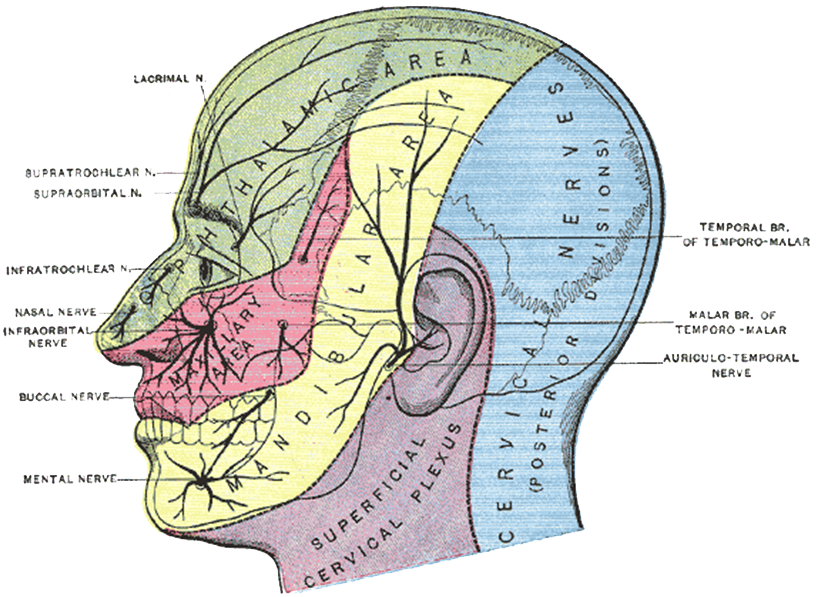Introduction
Persistent idiopathic facial pain (PIFP) also known as atypical facial pain (AFP), refers to pain over the cranio-facial region (Figure 1) that does not fit the classical presentation of other types of facial pain. It is characterized by unremitting pain often with variable and fluctuating intensity. No abnormality is usually detected during clinical and radiographic examinations.
PIFP is diagnostically challenging and patients are frequently misdiagnosed. Many people attribute their pain to a prior event, such as a dental procedure or facial trauma. PIFP is thought to be uncommon and mainly affects adults.

Figure 1: Sensory nerve distribution of the cranio-facial region
(Source : Reproduced from the 20th U.S. edition of Gray’s Anatomy of the Human Body)
Definition
PIFP has been defined by the International Headache Society as a persistent type of facial pain that does not have the characteristics of other types of facial pain and cannot be attributed to another disorder. PIFP usually does not have a specific cause.
Signs & Symptoms
- Pain is present daily and persists for most or all of the day
- Pain is confined at onset to a limited area but may spread later to wider areas and even at different sites
- Pain is usually moderate to severe in intensity.
- Pain cannot be attributed to any other disorder.
- Pain is poorly localized
- Pain is not associated with sensory loss
- NO obvious neurological deficits
Diagnosis
PIFP is a diagnosis of EXCLUSION usually based on information obtained from pain symptoms, clinical examination and imaging studies. A diagnosis of PIFP is usually rendered after excluding all other possible causes of oro-facial pain and NO obvious reasons for the pain were found.
Management
PIFP is usually managed through medication. The goal of therapy is to manage the pain effectively while giving rise to the fewest possible side effects from the medications. Many different types of medications may be used to manage the pain.
Commonly used medication groups are:
- Anti-epileptic drugs,
- Antidepressants
- Topical anaesthetics agent,
- Analgesics
- Anti-inflammatory agents
At times additional management techniques such as physiotherapy or acupuncture may be advised by the specialist. It must be stressed that immediate relief for this condition is not always possible and at times, a multi-disciplinary approach may be required to achieve satisfactory pain control.
References
- Olesen J, et al; The International Classification of Headache Disorders, 3rd edition, Headache Classification Committee of the International Headache Society, Cephalalgia, 33(9) 629-808 2013.
- Aggarwal VR, McBeth J, Zakrzewska JM, Lunt M, Macfarlane GJ. The epidemiology of chronic syndromes that are frequently unexplained: do they have common associated factors? Int J Epidemiol 2006;35:468–76.
- Harrison SD, Glover L, Feinmann C, Pearce SA, Harris M. A comparison of antidepressant medication alone and in conjunction with cognitive behavioural therapy for chronic idiopathic facial pain. Proceedings of the 8th World Congress on Pain. Seattle: IASP Press; 1997. p. 663–723.
| Last Reviewed | : | 13 June 2016 |
| Writer | : | Dr. Hans Prakash a/l Sathasivam |
| Accreditor | : | Dr. Lau Shin Hin |







